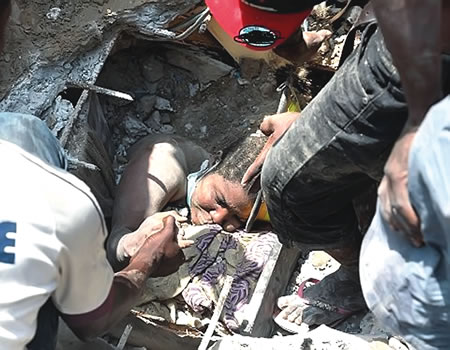Wednesday, March 13, 2019 will remain indelible in the minds of not just residents of Lagos Island; it was a day Nigerians will not forget that easily, as they were made to witness the horror of another building that collapsed and which claimed the lives of innocent children.
It had so happened several times in the past in Lagos, such that the state government came up with a law to acquire any land on which any building collapsed, perhaps to make owners of buildings take adequate measures on their properties and forestall the use of inferior materials during construction. But even after taking those measures, buildings have not stopped coming down in the state.
This time it was the turn of Massey Street, Lagos Island, where a three-storey building collapsed.
Though no official figure has been released by the government or emergency management authority in the state on the number of victims, Sunday Tribune gathered that no fewer than 20 people, mostly pupils of Ohen Nursery and Primary School situated on one of the floors f the building, had been confirmed dead. Scores of others, mostly survivors, were taken to Lagos Island General Hospital, Lagos University Teaching Hospital and other places where they are being treated.
The building
A resident of the area, who simply identified himself as Alhaji Adesina, while speaking with Sunday Tribune said: “It was really a sad experience. I have seen many incidents of collapsed buildings. None is as tragic as this one; maybe because of the large number of children involved. That building was built by a popular developer about 10 years ago. He developed other buildings on the island. He has another one near that place at Tinubu.
“It was one of the buildings that residents have been complaining about. About three years ago, officials of the Lagos State Building Control Agency marked the building for demolition. That was not the only building that was marked for demolition in that area. There is another one on Smith Street and there is also another one on the same Massey Street.”
Alhaji Adesina said the land on which the building stood used to be an open space and it belongs to three different families who are interrelated, but because they could not agree on what to do with the land they entered into an agreement with the developer called Giwa to construct a building on it.
One of the grandchildren of the original owners of the building, Erinoluwa Akinmoladun, who spoke with the Sunday Tribune, however, said the developer was yet to hand over the building to the family. “The agreement was for 10 years and it started in 2010 and will run till 2020,” Akinmoladun said.
Speaking on the tragedy, Akinmoladun said: “on the day that the house collapsed, the three different families were planning to meet and discuss with the developer on the necessary renovation work to be carried out on the building.”
He disclosed that there 10 families occupied the ground floor, first and second floors and the penthouse of the building. The school has been operating on the third floor for about seven years, according to him.
“It is true that the building was marked (for demolition) three years ago by officials of the Lagos State government, but I don’t know what the developer did. What we saw was that he came and did some renovations and that was it,” Akinmoladun added.
Sunday Tribune also gathered from residents of Massey Street that some occupants of the collapsed building were lucky as they had already moved out before the building caved in. One of the lucky ones was a woman identified simply as Iya Oyinbo, who was said to be squatting with a friend, then she got her own apartment and left.
Until the tragedy, Sunday Tribune was informed, many of the residents of Apatira and Massey streets did not know that there was a school in the operating inside the building. Many of them, who spoke with the Sunday Tribune expressed surprise at the reports that the school had a population of over 150 students.
A resident of a building adjacent to the school, Adewale Owoso told Sunday Tribune that “a lot of us stay and play in front of that building but we were not aware of the fact that there was a school there. There was no sign to indicate that there was a school in the building.”
Another resident, Iya Mola said: “Many people may not know that there was a school there. The woman (who owned the school) actually started the school in a small house not too far from the collapsed building and when the space became too small for the students, she relocated to an uncompleted building in front of the collapsed building.
“At that time, she was using the space on a decking but when parents started complaining and expressing fears over the safety of their children, she moved to the third floor of the collapsed building.
“Many people used to call the school Aunty Esther School. The owner was known as Aunty Esther; she was very good and hardworking and the school was very cheap.”
Escape from the clutch of death
Sunday Tribune learnt that some of the victims could have been saved if there was a coordinated rescue effort. Relevant government agencies that could have coordinated the operation did not arrive on time. It was not the best of rescue operations at the site of the incident. The topography of the environment, it was said, made things difficult. Before the arrival of the emergency team, residents were already annoyed and angry, alleging that they should have come much earlier than they came. They also complained about the emergency team’s tactics in the rescue operations.
One of the residents who were the first to arrive at the scene, and who identified himself as Owoso told Sunday Tribune that “immediately it (building collapse) happened, we mobilised and started bringing out the victims. The government people came about one hour after the incident happened. By the time they arrived, we had rescued over twenty people.”
Another resident, who identified himself as a pastor said: “the boys were more effective than the government people. When they came, for more than two hours they could not rescue anybody. They only came with an excavator and had to call on Julius Berger to bring a crane. The boys would have saved more lives.”
I told my father about the cracks on the wall…
Erinoluwa, one of the survivors in the building collapse had lost a sister exactly six years ago. The girl was one of the granddaughters of one of the owners of the building died. He had left the collapsed building less than 15 minutes before the accident that fateful day. He told Sunday Tribune his story.
“That day was exactly six years ago that my sister died. She was sick before she died. I had gone there in the morning as usual to see my father. I did not sleep there the night before and whenever I did not sleep there, I always go to see my father the following morning.
“My father was staying on the first floor but when I was about to ascend the stair case I noticed some cracks on the wall and I told him. He promised to call other members of the different families that occupy the building to meet and call the attention of the developer to the condition of the house,” he explained.
Speaking further, he said he later went downstairs and started playing with friends but became very uncomfortable.
“I felt a great uneasiness. I just had feelings to get out of the house. I told my friends. They didn’t take me seriously but I insisted and persuaded them to leave the building and we all left.
“I was just on my way to a place when I received a call that our house had collapsed. My mind quickly went to my father. My friends and I would have remained on the ground floor and only God knows what would have happened,” Erinoluwa said.
For the family of a security man, Kazeem Lawal, who worked as a bouncer in one of the hotels on Lagos Island, they would always remember the incident with mixed feelings. Kazeem died in the tragedy but his wife, Modinat, was lucky to have escaped death by the whiskers. The deceased security man, who was described as very peaceful had reportedly forced his wife to go and get food for him, when the house collapsed.
One of his friends, who identified himself as Alhaji Raheem told Sunday Tribune that: “the wife and the husband would have died in the incident. They lived on the ground floor. Kazeem came back from a night duty and wanted to eat. Their two children had gone to school. They don’t attend the school in that building. They attend another school in the neighbourhood.
Kazeem’s wife was planning to go to the market, but he sent her to go and get him food. Modinat (his wife) insisted that she would do that after being properly dressed up but Kazeem angrily shouted at her and forced her to go out and get the food but before she returned the building had collapsed.
I was already begging God for forgiveness —Survivor
A survivor, who was the head teacher of the school in the collapsed building, told Sunday Tribune that he had already resigned himself to fate and that he was already begging God for forgiveness thinking it was his last day on earth.
He said: “Some minutes before the building collapsed, I went downstairs to buy food and on my way up on the staircase, I felt like the earth was vibrating and suddenly the building came down.
“Initially, when the building collapsed, I didn’t know where I was until after some minutes. I saw a ray of light. It was then that I knew that I was under the rubble of the school. I spent about three hours before I could see the ray of light. Everywhere was dark; I was only hearing the cries of the pupils and the proprietress shouting ‘Jesus’ and one Baba Ridwan with whom we pray together in the same mosque.
“When I saw the ray of light, I tried to raise my hand. Someone then touched me and called my name and the person told me not to worry that they were coming to rescue me. It took the rescue team an hour before they could remove the slab that fell on me. It was when they removed the slab that I felt some relief because the heat was much. It got to a stage that I could not breathe anymore. It was God that saved me.”
Though the bereaved are still mourning their loved ones and the injured are thanking God for being alive, the bigger tragedy is that the concerned authorities often feel incapacitated to do the right thing, making the next building collapse an incident that is only a few days or weeks away.








